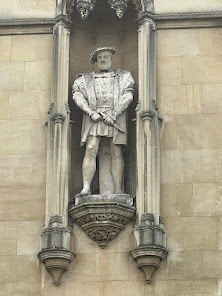 |
| Lincoln Cathedral seen from outside Bailgate at the top of Steep Street.. |
St. Hugh's saga began with the pride of King Henry (that’s Henry II). It’s well debated what he really intended by the oft quoted line “Will no one rid me of this meddlesome priest?” but most agree that it led to the murder of Henry’s Archbishop of Canterbury, Thomas Beckett. What followed was the need for Henry to demonstrate remorse and repentance proportionate to the crime committed. As part of that effort, Henry determined to build a Carthusian monastery dedicated to continual prayer. Things weren’t going well, so Henry appealed to the abbot of the Grand Chartreuse in France that Hugh, who was head of a daughter community of that monastery and whose fame had reached him through one of the nobles of Maurienne, was made prior of the faltering English community.
 |
| The ornate shrine where the reliquary containing St. Hugh's head once was displayed. Fortunately, his head is now with the rest of his remains. |
The long and short of it was that poor Hugh was even more popular after his death than before. The simple burial he requested was insufficient for the powers that be, and a grander place of visitation was planned, so his body was exhumed and translated to a special chapel built in his honor. When a second quire section (The Choir of the Angels) was completed, authorities planned a still more ornate resting place for the saint and his bones had to be moved yet again – and this time, regrettably, he literally lost his head – during the exhumation and translation to the new shrine it fell off! So, thought those in charge, all the better, now poor Hugh would be buried in two parts – so pilgrims could pay homage twice in one pilgrimage – and of course, donate twice to the upkeep of increasingly expensive grand cathedral. So, poor St. Hugh’s head was in one place, and his body in another, at least until they were finally reunited centuries later when he was reinterred in his final, final resting place.
 |
| Steep Street Note the angle of the curbing to the right. |
Remigius de Fécamp, became the first Bishop of Lincoln, sometime between 1072 and 1092 under the patronage of William the Conqueror, and laid the foundations of the Cathedral though he could not complete the whole of it before his death. Like his successor, Hugh, St. Remigius is also buried here.
The cathedral at Lincoln is a precious place. While we moderns are often obsessed with architectural purity, we find in a place like Lincoln a history of imperfection – not born of disrespect but symbolic of the progress of learning. As architects, masons, and other master builders learned the secrets of building these massive edifices, the mistakes inherent in the learning process become clear over time – and the cost involved of “erasing” previous ignorance make the appearance of perfection impossible. So, a building like Lincoln, begun long before the pinnacle of gothic knowledge and skill had been reached shows us a “learning curve” through history and gives us hope that we, too, can learn from out mistakes.
 |
| The nave looking back from the altar at the crossing |
 |
| See the imp seated at the base of the arch point cross-legged and impertinent. |
 |
| The "Word Made Flesh" |
 |
| The baptismal font |





























.JPEG)
.JPG)







